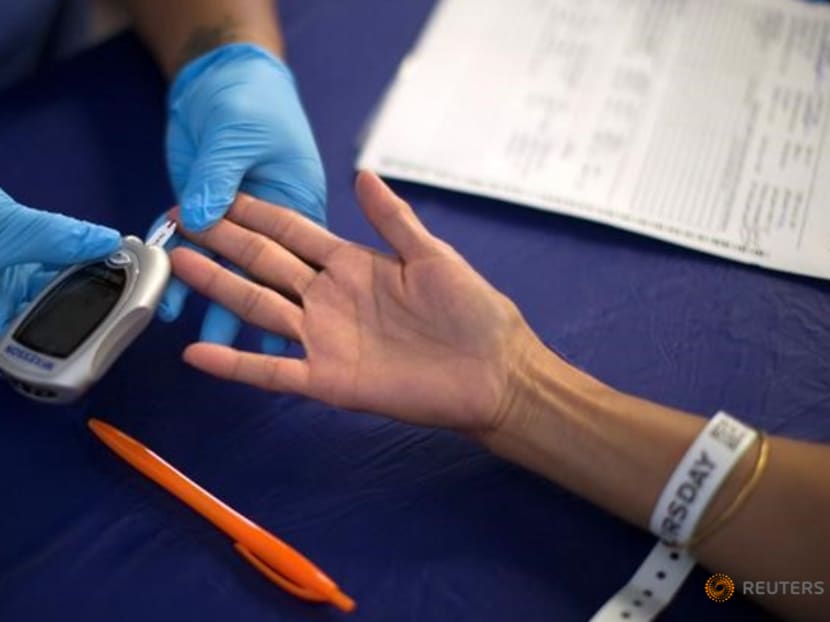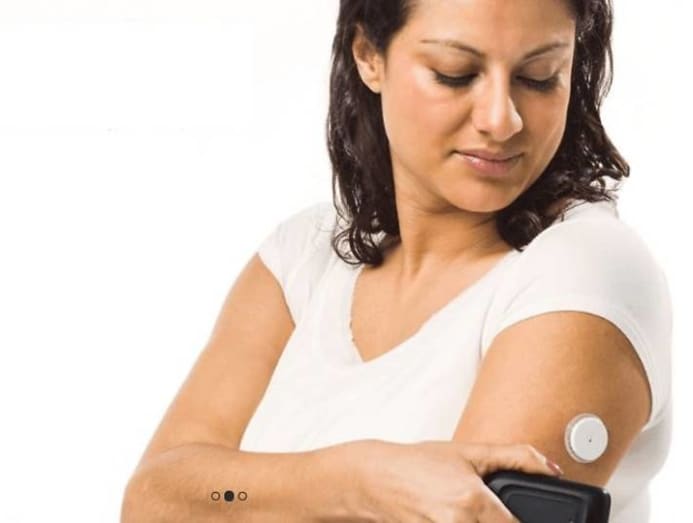commentary Commentary
Commentary: Reclaiming control over diabetes, one device at a time
We can win this war on diabetes and manage its daily struggles with stronger resolve and a nudge from technology, argues Diabetic Society of Singapore's Dr Kevin Tan.

A diabetic patient receives a finger-prick blood test. (File photo: Reuters/Mario Anzuoni)
SINGAPORE: Diabetes, one of Singapore’s medical scourges, has been actively discussed, particularly in light of Prime Minister Lee Hsien Loong’s National Day Rally speech.
“If you look at the top causes of death in Singapore, diabetes does not appear there but actually, many common causes of death can be traced back to diabetes,” said Mr Lee.
Today, diabetes affects one in nine Singaporeans and among those over 60, three in 10 have diabetes. The onset of diabetes is also getting younger with each generation - overweight teenagers can now succumb to what was previously termed “adult-onset” or Type 2 diabetes, the most common form.
Managing diabetes is difficult, with a third or more not controlling their condition well enough. Meal times, for instance, require careful thought to ensure the proportions of food and diabetes medication are right to stabilise blood glucose levels.
Planning food portions is no simple matter either, since carbohydrates have to be counted as precisely as possible.
For people living with diabetes, too little food could result in dangerously low blood glucose levels, while too much may cause blood glucose levels to spike. Both could be fatal.
Exercise should also be coordinated to meal and medication schedules – but this all depends on constantly checking your blood glucose levels.
Imagine doing all this every day and you can understand why individuals get frustrated managing their condition.
Unfortunately, failure to do so could lead to an increased lifetime exposure to and a higher risk of diabetes-related complications: Blindness, amputations, kidney failure, stroke and heart attack.
Effective management of diabetes is a pressing issue, but more of the same would lead to naught. A fresh perspective leveraging the right tools to empower people living with diabetes in their decision-making is needed.
The war on diabetes may be waged on a national level, but on a personal and clinical level, we need to deploy smart solutions that can empower people living with diabetes to make an informed decision about their dietary and lifestyle choices. It is only through the use of smart technologies are they given a chance to fight back.
THE DAILY STRUGGLE
Take the example of a diabetic patient I see, John*, who is in his twenties. John has had Type 1 diabetes since he was 13 and has lived with the condition for over a decade.
The insulin-producing cells in his pancreas were destroyed by his immune system. He has to give himself four to six insulin injections every day not just to control his blood glucose levels, but to survive.
Without insulin, his body would be unable to utilise carbohydrates, protein and fat to provide energy and he would waste away until death. A perfect match of insulin doses to his food intake is needed to maintain normal blood glucose levels throughout the day.
Yet, for the last 40 years, the only method to measure blood glucose levels has been to prick one's finger with a needle.
Invasive, painful and a tedious process to repeat every time John wants a reading, this has been a discouraging factor to John, who seeks to control his blood glucose.
This measure also only gives a snapshot of John's blood glucose levels at that particular point in time.
It is frustrating indeed that the fight against diabetes is one that occurs on a daily, even hourly basis, but John’s attempts to stay on top of it are limited by the inadequacies of existing monitoring methods.
He feels defenseless and powerless in the face of a disease that is seemingly larger than life.
He is not alone, with millions of others worldwide facing the same challenge. But this may change.
DIABETES IN THE DIGITAL AGE
The introduction of wearable devices marks one of the most exciting developments in healthcare technology. These seemingly simple devices have been transformative in the way we approach chronic disease management, providing real time data to inform decisions.
In diabetes, this change is most significant with Flash Glucose Monitoring. Glucose sensors conveniently attached to the back of the upper arm measure glucose levels and can be scanned with a reader at will.
In one swipe, current glucose readings, an eight-hour history of glucose levels, and a trend arrow indicating their likely direction are available to the wearer. It also only needs to be changed every two weeks.

The benefit that Flash Glucose Monitoring provides are far beyond glucose monitoring alone. Instead, the sense of control one has over his or her condition takes huge emotional pressure off a patient’s mental state of mind.
For doctors, the data obtained from Flash Glucose Monitoring systems can be read through a standardised visualisation chart, or an ambulatory glucose profile, which offers reliable and predictive trends of a patient’s glucose readings. With a clearer picture of the patient’s condition, doctors can tailor treatment regimens, choice of medicine and dosing more precisely to the individual’s needs.
People living with diabetes need no longer live in the dark ages. It is time for them to join the digital era of health.
GOING BEYOND SMART CHOICES
Singapore’s Smart Nation vision is one of using smart solutions to empower citizens and promote a better quality of life.
With Singapore having an increasing number of young persons with diabetes - among the youngest population of diabetics in the world, with three in 10 Singaporeans succumbing to diabetes before the age of 40, the integration of such smart technologies can give a huge boost to its soldiers in the war against diabetes.
Diabetes solutions have made tremendous progress, yet there is still a lag in terms of people’s willingness to adopt the latest available technology.
Barriers include the additional cost of new technologies whose benefits are not immediately tangible, diabetics not wanting to be constantly reminded of their chronic condition, and frustration with the constant need to manage their food choices, exercise and lifestyle no matter how much data simplifies some decisions for them.
Technology cannot offer a cure-all, but it does promise to make it more convenient for chronic disease patients to take better care of themselves – if they want to.
Public education and awareness must help bridge the gap.
Effective management of diabetes is closer than we think, but only if we put the spotlight on smart technology, and our willingness to use it to empower ourselves.
*Not his real name.
Dr Kevin Tan is the vice-president of the Diabetic Society of Singapore and an endocrinologist practising at Mount Elizabeth and Mount Alvernia hospitals.
Read also commentaries on why Singaporeans are particularly vulnerable to diabetes and whether intermittent fasting can help tackle this condition.





